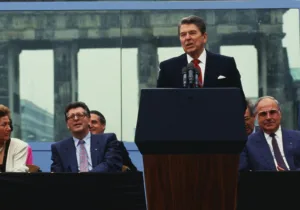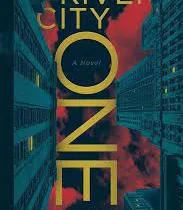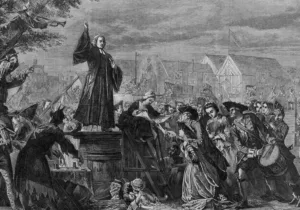In a speech to Congress in 1990, President George H. W. Bush declared: “we stand today at a unique and extraordinary moment…a new world order can emerge – freer from the threat of terror, stronger in the pursuit of justice, and more secure in the quest for peace.” President Bush’s words echoed Francis Fukuyama’s claim that the fall of Communism had ushered in “the end of history,” where “economic calculation, the endless solving of technical problems… and the satisfaction of sophisticated consumer demands” would replace great the religious and ideological conflicts plaguing human history from time immemorial.
Thirty years on, even the most ardent supporters of liberal internationalism have conceded that this new world order has failed to materialize as its most zealous proselytes promised; the post-Cold War consensus is well and truly over. With an ongoing war in Europe, even liberal internationalists have had to concede (perhaps overgenerously) to the ‘realist’ vision of international politics based on the perpetuality of great power rivalry and the return of geopolitics. For George Kennan, an American diplomat turned academic, this would not have been a surprise. Even during the years of high optimism following the fall of the Iron Curtain, Kennan warned that the prevailing post-Cold War neoliberal consensus was more vulnerable than ever before.
Kennan rose rapidly in the American foreign policy establishment, first being noticed while serving as a mid-level staffer under the watchful eye of the legendary Averill Harriman. His 1947 article, The Sources of Soviet Conduct, provided the intellectual framework for the United States’ strategic vision for the next four decades. Written while serving as an American diplomatic advisor in postwar Moscow, it emphasized containing the Soviet Union by allowing it an eastern sphere of influence in Europe, rapidly increasing nuclear arms proliferation, and preparing for the inevitable implosion of the Communist military-industrial complex which would struggle to keep up. Kennan, still a young diplomat at the time of this breakthrough, seemed destined for a glorious diplomatic career at the heart of the American foreign policy establishment. Yet, less than six years later, he would find himself fired by a frustrated President Eisenhower.
Despite his best hopes, Kennan would never return to frontline politics. Though certain he would receive a recall from D.C. that would reestablish him at his rightful place as the left-hand man of the President, he waited in vain. He desired the influence of the Secretary of State, National Security Advisor, or a prestigious ambassadorial role, but his best offer was a second-tier ambassadorial posting in Yugoslavia under President John F. Kennedy. Frank Costigliola’s new book ‘Kennan: A Life Between Worlds’ (Princeton University Press, 2023) sheds new light on the strange death of Kennan’s promising career.
Kennan’s ideas have had something of a renaissance in the past decade, coinciding with the collapse of the post-Cold War neoliberal consensus he so cynically decried. Costigliola’s biography comes as only the latest contribution to the emerging literature on Kennan. The attempt to write a new biography of George Kennan, just a decade after John Lewis Gaddis’ Pulitzer Prize-winning work, George F. Kennan: An American Life, is no mean feat. However, A Life Between Worlds holds its own given Costigliola’s extensive use of Kennan’s diaries; materials that Gaddis (upon Kennan’s insistence) chose not to touch.
This choice of sources is augmented by Costigliola’s intention to recover the “inner” life of Kennan. Through a blending of psychoanalytic insights with more conventional source-based historical investigation, A Life Between Worlds provides a fresh perspective on one of the most original intellectuals of the mid-twentieth century.
Kennan was an admirer of the 18th-century historian Edward Gibbon, and he voraciously read the ‘History of the Decline and Fall of the Roman Empire’ on his regular trips across the Atlantic. Gibbon’s demythologizing idea of empire informed Kennan’s own doubts about the modern American empire’s supremacy. Contrary to the all too common “realist” caricature of Kennan, it was less the great exponents of egotism à la Machiavelli or Hobbes that influenced his worldview, than the Russian naturalists like Anton Chekov and Leo Tolstoy. Kennan insisted that industrialism, due to the tremendous environmental damage it wreaks on the natural world, was a more pressing existential threat than any weapon in the Soviet arsenal. His warnings fell on deaf ears.
Although he made his name as an early American strategist during the Cold War, Kennan was no democrat; it wasn’t the mere presence of authoritarian leaders that made him despise Soviet Communism and National Socialism. Rather, Kennan regarded Hitler and Stalin as leading regimes that had perverted the imperial heritage of formerly great nations by stirring up the masses to support utopian political projects. He blamed modern mass democracy for igniting uncontrollable social tension. Far from a hard-nosed realist, Costoligla’s Kennan was a romantic. In addition to being fluent in their languages, Kennan was also immersed in the art, music, and literature of Russia and Germany. His knowledge underpinned a quasi-spiritual idea of these nations and admiration for their aristocratic culture, perhaps explaining his own preference for a mode of government tempered by the stewardship of wise men and technical elites, like himself. As any romantic would, Kennan blamed industrialism for the spiritual corruption of Germany and Russia that led to Fascism and Communism gaining power.
Kennan was at heart a historian, and a historian who could not escape his nostalgia for the view of statecraft and empire inherited from his interpretation of 18th-century European history. This was often to his own detriment as a diplomat, where this romanticism often made him unwilling to compromise to the realities of modern geopolitics. This frustrated his superiors, most notably Averill Harriman and Dean Acheson. This feeling was somewhat mutual, however, as Kennan had little time for their ideas, dismissing them as unimaginative and technocratic. He repeatedly refused to cooperate with official state policy that supported the division of Germany. Adamant that political problems had historical causes that offered enough insight about nations to make informed policy decisions, Kennan aired his disagreements to an unassuming journalist at a Moscow airport. Amidst the subsequent scandal, Eisenhower removed him from public office.
Kennan’s departure was followed by a return to hawkishness within the Eisenhower administration, championed by the Secretary of State and his former colleague at the State Department, Dean Acheson. Kennan made his feelings clear about his displeasure at this in his 1957 Reith Lectures, broadcast by the BBC. In six, hour-long radio lectures, Kennan set out his latest idea, a strategy dubbed ‘disengagement’. The motivation for these lectures was Kennan’s claim that his earlier doctrine of containment had been misinterpreted.
Rather than an end in itself, containment should have been seen as a means to an end. Kennan believed the goal of containment was to bring both powers to the negotiating table, not as the platform to launch a zero-sum arms race. Kennan argued US policy should be directed towards the disarmament of Europe, with a reunified and neutral Germany as a buffer between the US and the Soviet Union. Arguing that Khrushchev’s Soviet Union was not an existential threat to the West, Kennan proposed disarmament and recoupling as both a safer and more responsible resolution of the Cold War. Although these ideas were well received by the general public, they were anathema to Western statesmen of the day, most notably West German Chancellor Konrad Adenauer, who fumed to his American colleagues that such a naïve and dangerous idea could be peddled by so influential a commentator.
Kennan was frustrated by the rejection of his ideas by foreign policy insiders. Even so, he began to understand the tremendous influence he possessed in shaping public opinion as an enlightened outsider. Kennan was encouraged by the popularity of the Reith Lectures and began to build a platform as a public intellectual, offering critique and comment on the pressing geopolitical issues of the day. Though never at the heart of state power, Kennan’s wise counsel was sought from political actors across the spectrum, from the neoconservative Colin Powell to the liberal interventionist Bill Clinton.
Some of his most provocative insights emerged towards the end of the Cold War. Far from regarding the fall of Communism as the ultimate triumph of liberal democracy and capitalism, let alone the “end of history,” Kennan felt history was just getting started. Ever the pessimist, he argued that the removal of the Russian hand from the Balkans would release the region’s “romantic and intolerant and dangerous nationalism.” A vocal critic of NATO expansion in the 1990s and 2000s, Kennan argued that NATO should be disbanded and replaced with a pan-European security infrastructure with the US playing a reduced role in European defense. He later became a friend and confidant to Mikhail Gorbachev, who shared his vision of Russian reintegration into “European civilization.”
Costigliola devotes the entirety of his final chapter to these post-Cold War projections. The constant cross-referencing to Russia’s invasion of Ukraine suggests he revisited the manuscript after Putin’s invasion. Yet, the belabored references to Kennan as a prophet of the Ukraine War, and the implication that NATO expansion was to blame for it, are no more convincing coming from an academic than it is from navel-gazing political commentators. Kennan, towards the end of his life, became more of a provocateur on issues such as these, displaying a moral relativism in international politics that his mid-Century Christian realist interlocutors, Herbert Butterfield, and Reinhold Niebuhr would have detested.
Reviving an interest in Kennan’s political insights such as disarmament as a solution to nuclear threats, the importance of negotiation with the “enemy,” and an appreciation of historical insights in informing policy decision, is however a worthy cause. In championing such causes, however, Costigliola glosses somewhat uncritically over the more reactionary nature of Kennan’s views about Central and Eastern Europe. Mocking the independence movements of the former satellite states, Kennan dismissed them as “excited peoples” insufficiently experienced in self-government and lacking deference to “Russian security interests” necessary to maintain independence.
Costigliola concludes that Kennan was a great diplomat, who was simply misunderstood by his bureaucratic superiors. This assessment seems a little off the mark. If diplomacy is the art of moving political leaders to places they are reluctant to go, Kennan fell at the first hurdle. Regarding himself as a renaissance man in a world of cavaliers, Kennan had little time for those he considered his intellectual inferiors. He could be abrasive, impatient, and dogmatic, unable to reach compromise on the technicalities of policy. He was an elitist, much more comfortable in the presence of intellectuals Isaiah Berlin or Ernst Kantorowicz than career diplomats like Dean Acheson or John Foster Dulles.
The introspective Kennan was well aware of his limits, confessing in his diaries that he had influence “almost everywhere but where it counts.” While consistently producing brilliant analytical insights, his remarks that President Roosevelt was a “superficial, ignorant dilettante, a man with a severely limited intellectual horizon” capture Kennan’s disrespect and inability to work with those in politics he deemed his intellectual inferior. For all his insight, Kennan failed to accept that politics requires not just to winning the battle of ideas, but also to practically maneuvering to deliver results in real-time, even if it requires comprising on intellectual purity for the greater strategic good.
Yet in spite of these shortfalls, George Kennan’s life was not a failure, even if he himself may have felt that way. Had Kennan not made the begrudging switch from the hands-on world of high diplomacy to the more reflective realms of academia, the West would have been deprived of a critical voice that challenged many of the hawkish pretensions of the American Cold War foreign policy establishment. A man of ideas, Kennan’s was the rare voice providing conceptual clarity and historical grounding in an age of realpolitik.
George Kennan deserves to be taken seriously, regardless of whether one agrees or disagrees with the content of his ideas. A true intellectual, Kennan’s thought demonstrate the importance of thinking about politics conceptually. In a political culture dominated by short-term thinking, Kennan’s example highlights the importance of thinking about the longue durée in politics. While getting the technicalities of policy right will always be important, Kennan’s work reminds us that policy never emerges from an ideological vacuum, challenging us to think about the ideas that underpin our institutions. Kennan insisted that historically informed political philosophy can play an essential role in re-intellectualizing political debates that have fallen foul to predictable soundbites on one hand and technocratic musing on the other. In this moment of existential reckoning for the Western liberalism, this way of thinking is needed more than ever. In his life, Kennan authored seventeen books, publishing provocative classics such as American Diplomacy (1951) or Around the Cragged Hill (1978), winning the Pulitzer Prize twice. Perhaps Kennan can be forgiven his intellectual pride. It remains to be seen whether scholars and politicians today take heed of his example.
Frank Costigliola: Kennan, A Life Between Worlds (Princeton 2023).







 Sponsor a student for Christianity & National Security 2024
Sponsor a student for Christianity & National Security 2024